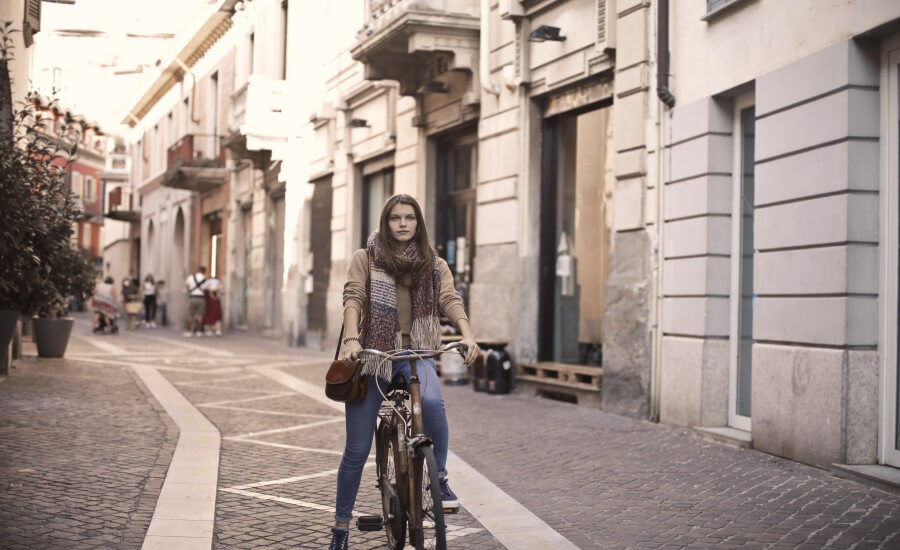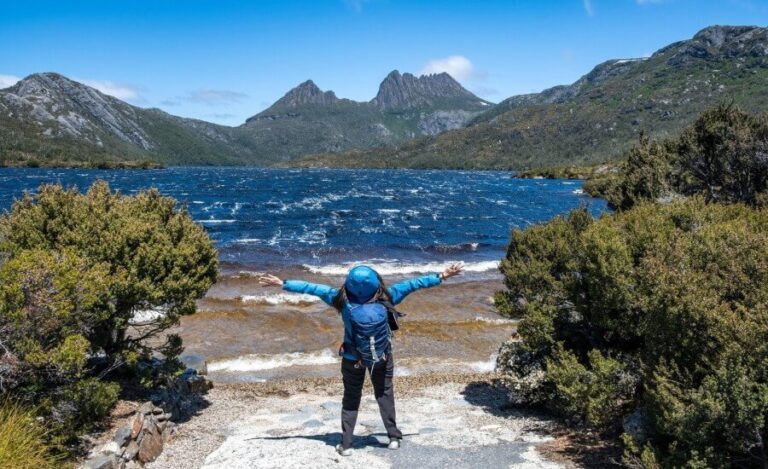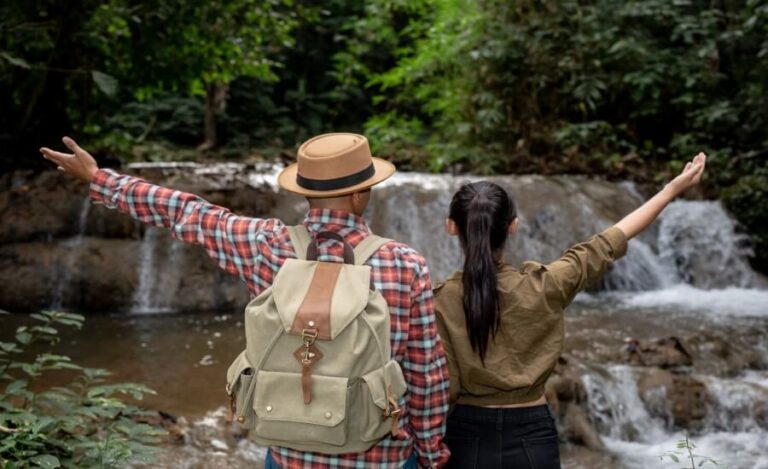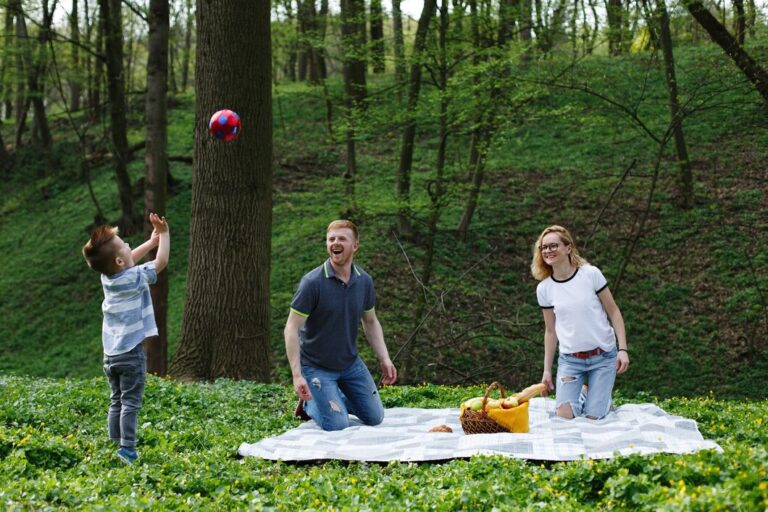
The morning sun casts long shadows across ancient cobblestones as you pedal slowly through a medieval square. The only sounds are the gentle whirr of your bicycle chain, church bells chiming in the distance, and occasional greetings from shopkeepers arranging their wares for the day. No traffic jams, no tour bus engines, no smartphone notifications interrupting the moment. You pause to breathe in the scent of fresh bread from a centuries-old bakery, noticing architectural details overhead that would be missed from a car or during a rushed walking tour. This is mindful travel as it was meant to be experienced – mindfully, intimately, and at the perfect pace to absorb every sensory detail.
In our hyperconnected era of high-speed travel and digital documentation, we’ve lost something essential about the journey itself. We arrive at destinations only to experience them through our screens – navigating with GPS rather than observation, photographing rather than seeing, and checking social media rather than engaging with our surroundings. The authentic connection with place becomes secondary to its digital representation.
Bicycle travel through Europe’s historic towns offers a compelling alternative – a perfect middle path between the slow immersion of walking and the distance-covering capacity of motorized transport. On two wheels, you experience destinations at a pace that humans evolved to process information – fast enough to cover substantial ground but slow enough to absorb sensory details, historical context, and cultural nuances that flash by unnoticed in faster modes of travel.
In this guide, you’ll discover ten remarkable bike routes through Europe’s most captivating historic towns – itineraries specifically designed to maximize authentic connection by minimizing both physical and digital barriers between traveler and place. You’ll learn how disconnecting from technology while cycling these routes can transform ordinary tourism into extraordinary journeys of discovery, revealing dimensions of Europe’s living history inaccessible to the digitally tethered traveler.
Why Bicycling Creates the Perfect Unplugged Experience

Before exploring specific routes, it’s worth understanding why cycling creates uniquely favorable conditions for unplugged, mindful travel experiences – particularly in historic European settings.
The Perfect Pace for Human Perception
Human cognitive architecture evolved long before mechanized transportation. Our perceptual systems developed to process information while walking or running – roughly 3-15 miles per hour. Modern transportation moves us far faster than our senses can meaningfully absorb our surroundings.
Bicycling operates precisely within this evolutionary sweet spot – fast enough to cover significant territory while remaining slow enough for our senses to process the environment in rich detail. This optimal speed allows cyclists to notice architectural features, detect subtle changes in neighborhood character, and absorb the sensory landscape in ways impossible at higher speeds.
Research in environmental psychology confirms this phenomenon. Studies of environmental perception show that subjects traveling by bicycle retain approximately three times more detailed observations about their surroundings than those in motorized vehicles covering the same route.
Natural Technology Disconnection
Unlike driving (which requires navigation systems in unfamiliar territory) or walking (which often involves frequent phone checking for directions), cycling creates natural conditions for technology disconnection:
- Safety Requirements: The need to keep hands on handlebars and attention on surroundings makes phone checking impractical and dangerous.
- Flow States: Cycling’s physical rhythm naturally induces what psychologists call “flow states” – periods of focused immersion where distractions naturally fall away.
- Sensory Engagement: The multisensory nature of cycling – feeling road textures, detecting subtle grade changes, navigating based on environmental cues – occupies perceptual bandwidth typically filled by devices.
- Natural Breaks: Bicycle travel creates organic stopping points at vistas, town squares, or interesting discoveries – moments that become opportunities for presence rather than photography.
Optimal Access to Historic Centers
European historic towns developed long before automobiles, creating urban fabrics precisely scaled to human-powered transportation. Bicycles provide unique advantages in these environments:
- Access Beyond Barriers: Many European historic centers restrict automobile traffic, making bikes the fastest mode of transportation through these areas.
- Parking Convenience: Bicycles can be locked directly at destinations, eliminating both parking stress and the long walks from distant car parks.
- Infrastructure Advantages: Many European towns have invested in dedicated cycling infrastructure that often provides more direct routes than car traffic.
- Scale Compatibility: The compact nature of historic centers matches perfectly with cycling range – allowing comprehensive exploration without exhaustion.
Key Points:
- Cycling pace (8-12 mph average) aligns with human perceptual processing capabilities
- Physical engagement naturally reduces digital distraction
- Flow states emerge more readily during rhythmic cycling activity
- Historic European centers were designed at a scale ideal for bicycle exploration
- Research shows cyclists notice three times more environmental details than motorists
Top 10 Historic Town Bicycle Routes for the Unplugged Traveler

1. The Medieval Pearls of Bruges and Ghent, Belgium
Belgium’s Flanders region offers perhaps the perfect introduction to European bicycle travel through historic settings – flat terrain, exceptional infrastructure, and remarkably preserved medieval towns connected by scenic canal paths.
This 45-mile (72km) route connects two of Europe’s most extraordinary medieval centers – Bruges and Ghent – via the picturesque Bruges-Ghent Canal path. The predominantly car-free route follows peaceful waterways lined with windmills, historic locks, and countryside cafés, while both terminus cities offer compact historic centers ideal for exploration on two wheels.
Bruges presents a meticulously preserved medieval dreamscape of cobbled lanes, arched bridges, and step-gabled houses reflected in tranquil canals. The entire historic center operates as a near car-free zone, with priority given to pedestrians and cyclists. Dedicated bike paths create logical circuits connecting major landmarks – the soaring Belfry, magnificent Markt square, and serene Begijnhof – while avoiding the most congested pedestrian zones.
Ghent offers a more lived-in medieval experience, where historic architecture serves contemporary life rather than tourism alone. Its car-restricted center makes cycling the most efficient way to connect remarkable sites like Sint-Baafskathedraal (home to the Van Eyck masterpiece “The Adoration of the Mystic Lamb”), the imposing Gravensteen castle, and the medieval guildhalls of Graslei and Korenlei along the central canal.
What makes this route ideal for unplugged travel is Belgium’s exceptional cycling infrastructure combined with the visual richness of its historic centers. Well-marked paths eliminate the need for constant navigation checks, while the sensory density of medieval environments keeps attention firmly in the present moment. The natural rhythm of canal paths induces meditative states impossible when constantly consulting devices.
Unplugged Experience Highlights:
- Morning navigation through Bruges before tourist crowds arrive
- Midday picnic at restored lock-keeper’s cottage along the canal route
- Afternoon exploration of Ghent’s medieval core with stops for regional specialties
- Evening return along the canal as sunset transforms the landscape
Practical Information:
- Difficulty: Easy (flat terrain, dedicated paths)
- Distance: 45 miles round-trip (can be divided across multiple days)
- Bike Rental: Multiple locations in both cities offering quality city and touring bikes
- Best Times: April-June and September-October for mild weather and fewer tourists
- Accommodation: Historic center hotels in both cities offer secure bicycle storage
Unplugged Traveler Testimony: “I planned to constantly check my cycling app for directions between Bruges and Ghent, but I quickly realized the route was so well-marked that I could put my phone away entirely. Without digital distractions, I started noticing details – the different brick patterns on canal buildings, the subtle changes in vegetation along the water’s edge, the way light played on the surface at different times of day. I had cycled to ‘see’ two famous cities but found the journey between them equally compelling once I was fully present for it.” – Michael, 41
2. Loire Valley Château Trail, France

France’s Loire Valley offers the perfect combination of relatively flat terrain, spectacular historic architecture, and dedicated cycling infrastructure specifically designed to showcase the region’s remarkable château heritage.
The Loire à Vélo route stretches 560 miles along France’s longest river, but this 30-mile segment between Blois and Amboise captures the essence of the region’s historical richness. The route connects multiple UNESCO World Heritage châteaux while following peaceful riverside paths and country lanes through vineyards and forests.
The journey begins in medieval Blois, whose remarkable tiered cityscape rises dramatically from the Loire River. Its impressive château showcases architectural styles spanning four distinct periods, with spiral staircases and ornate galleries that reward careful observation. The town’s narrow medieval streets and renaissance squares are ideally explored by bicycle, with dedicated paths connecting major sites.
Between major destinations, the route passes through timeless villages and scenic landscapes that would be missed entirely by travelers focused only on château-hopping by car. The smaller châteaux of Chaumont-sur-Loire and Nitray provide intimate counterpoints to the grander royal residences, often with fewer visitors and more authentic atmospheres.
The route concludes in Amboise, where Leonardo da Vinci spent his final years under the patronage of François I. The town’s compact historic center, crowned by its imposing riverside château, offers easy cycling exploration with dedicated paths connecting key sites including Clos Lucé, Leonardo’s final home now showcasing his inventions and ideas.
What makes this route ideal for unplugged travel is its natural rhythm of alternating focused exploration (châteaux interiors) and contemplative cycling through pastoral landscapes. This pattern creates natural technology breaks as devices are stowed during cycling segments, while the visually rich environments hold attention without digital supplementation.
Key Points:
- Dedicated Loire à Vélo paths eliminate navigation stress
- Historic sites create natural technology breaks between cycling segments
- Moderate distances allow unhurried enjoyment without physical strain
- Smaller villages between major sites offer authentic French experiences
- Vineyard stops provide opportunities for regional wine appreciation
3. The Island Monasteries of Lake Constance, Germany/Switzerland/Austria

Where the borders of Germany, Switzerland, and Austria meet around the shores of Lake Constance (Bodensee), a remarkable 170-mile dedicated bicycle path circles the entire lake, connecting medieval towns, baroque churches, and island monasteries in one of Europe’s most popular cycling routes.
This 40-mile segment focuses on the lake’s western basin, connecting the medieval island town of Lindau (Germany), the ancient monastery island of Reichenau (Germany), and the perfectly preserved lakeside town of Stein am Rhein (Switzerland). The predominantly flat route follows dedicated lakeside paths with spectacular Alpine views across crystal waters.
Lindau’s island old town presents a remarkably intact medieval and renaissance cityscape, with its famous harbor entrance guarded by a 13th-century lighthouse and stone lion. The car-restricted island creates ideal cycling conditions for exploring narrow lanes lined with half-timbered buildings and hidden courtyards impossible to appreciate from tour buses that merely stop at the harbor.
Between major destinations, the route passes through working vineyards rising from lakeshores, traditional fishing villages, and nature reserves teeming with birdlife. These transitional landscapes provide contemplative cycling ideal for processing the historical richness of the main destinations.
The UNESCO World Heritage island of Reichenau reveals early medieval religious history through three remarkable Romanesque churches containing rare 10th and 11th-century wall paintings. The island’s agricultural traditions continue in its vineyards and specialty vegetable farms, creating a living landscape virtually unchanged for centuries.
The route concludes in Stein am Rhein, where Switzerland’s most impressive ensemble of medieval and renaissance buildings surrounds a perfectly proportioned town square. The buildings’ elaborate façade paintings require the unhurried appreciation that cycling visitors can provide, with details impossible to notice from cars or during rushed tour group visits.
What makes this route ideal for unplugged travel is the counterpoint between expansive lake views during cycling segments and the intricate historical details at destinations. This movement between broad landscapes and focused historical encounters creates natural rhythm for presence without technological mediation.
Unplugged Experience Highlights:
- Dawn departure from Lindau’s harbor with Alps silhouetted across the lake
- Midday exploration of Reichenau’s ancient churches without digital distraction
- Afternoon lakeside cycling with multiple swimming opportunities
- Evening arrival in Stein am Rhein as setting sun illuminates painted façades
Practical Information:
- Difficulty: Easy (flat terrain, dedicated paths)
- Distance: 40 miles (can be extended by continuing around the lake)
- Bike Rental: Available in all major lakeside towns with one-way drop-off options
- Best Times: May-June and September for pleasant temperatures and fewer tourists
- Ferry Connections: Multiple lake ferries accept bicycles for creating custom routes
4. The Medieval Hill Towns of Umbria, Italy
While Italy’s Tuscany receives more cycling attention, neighboring Umbria offers equally spectacular landscapes with fewer tourists and some of Italy’s most extraordinary medieval hill towns. This more challenging 60-mile route connects Assisi, Spello, Bevagna, and Montefalco through olive groves, vineyards, and cypress-lined country roads.
Unlike flatter European cycling routes, this itinerary embraces the rhythmic ascents and descents that define the Umbrian landscape. Each climb rewards cyclists with spectacular vistas and the anticipation of historic towns crowning distant hills, while descents provide exhilarating counterpoints to climbing efforts.
The journey begins in Assisi, whose pink-stoned medieval cityscape rises dramatically against Monte Subasio. While the Basilica of St. Francis justifiably draws attention, cyclists can explore the less-visited upper town with its Roman remains and panoramic overlooks. Bicycle access allows visitors to quickly escape crowded main streets for tranquil exploration of hidden corners impossible to reach efficiently on foot.
Between hill towns, the route traverses the Valle Umbra, a fertile plain of olive groves, vineyards, and ancient farmhouses. These agricultural landscapes provide contemplative cycling segments where the rhythm of pedaling aligns with the timeless patterns of cultivation visible in every direction.
The smaller towns of Spello, Bevagna, and Montefalco offer increasingly authentic experiences as they receive fewer international visitors than Assisi. Spello’s flower-lined medieval streets, Bevagna’s remarkable Roman mosaics, and Montefalco’s extraordinary Renaissance frescoes reward unhurried exploration, with each town small enough to traverse by bicycle in all but the most central pedestrian zones.
What makes this route ideal for unplugged travel is how the physical challenge of cycling creates natural immersion in the journey. The concentration required for climbs and descents eliminates digital distraction, while the sensory richness of the landscape holds attention without technological supplementation.
Key Points:
- Physical challenge of hill terrain naturally focuses attention on immediate experience
- Smaller towns offer authentic interactions impossible in more touristed areas
- Agricultural landscapes between towns showcase living traditions stretching centuries
- Sagrantino wine region provides natural stopping points to appreciate local production
- Roman and medieval layers visible throughout route create historical narrative
5. The Medieval Universities: Oxford to Cambridge, England
England’s two ancient university cities – Oxford and Cambridge – have maintained cycling cultures for centuries, with students and professors traversing cobbled lanes on bicycles since Victorian times. This 85-mile route connects these academic treasures via quiet country lanes, riverside paths, and picturesque villages largely unchanged since medieval scholars traveled between them.
The route begins in Oxford, “city of dreaming spires,” where cycling provides the most efficient means to connect the university’s 38 colleges scattered throughout the historic center. Dedicated bike lanes and restricted vehicle access make two-wheeled exploration ideal for discovering hidden quadrangles, walled gardens, and riverside paths largely invisible to conventional tourists.
From Oxford, the route follows the River Thames (locally called “the Isis”) northward before transitioning to quiet country lanes through the rolling Chiltern Hills. This landscape of ancient woodlands, hedge-lined fields, and flint-stone villages creates perfect conditions for contemplative cycling, with natural beauty holding attention without digital supplements.
The middle section traverses less-visited historic market towns like Bicester and St. Neots, where medieval market squares, coaching inns, and parish churches showcase English history without tourist crowds. These authentic communities provide glimpses into everyday English life impossible to experience from tour buses following main highways.
The route concludes in Cambridge, where the River Cam creates a verdant spine through college grounds dating to the 13th century. The city’s compact historic center and extensive car restrictions make cycling the optimal transportation mode, allowing visitors to efficiently connect landmarks like King’s College Chapel, the Mathematical Bridge, and the Museum of Archaeology and Anthropology.
What makes this route ideal for unplugged travel is its literary and intellectual associations. From landscapes described by Thomas Hardy to villages that inspired J.R.R. Tolkien, the route passes through settings that reward knowledge of English literature and history – creating perfect opportunities for recalling information rather than Googling it.
Unplugged Experience Highlights:
- Dawn cycling through Oxford’s historic center before tourist crowds arrive
- Midday pub lunch in unchanged medieval village
- Afternoon navigation of rural English lanes using traditional signposts
- Evening punting on the Cam after securing bicycles for the day
Practical Information:
- Difficulty: Moderate (rolling terrain with occasional steeper sections)
- Distance: 85 miles (typically divided across 2-3 days)
- Bike Rental: Multiple locations in both cities with one-way options available
- Best Times: May-June and September for pleasant temperatures and full university atmosphere
- Accommodation: Historic coaching inns in market towns offer secure bicycle storage
Unplugged Traveler Testimony: “I initially planned to use Google Maps constantly during my Oxford to Cambridge ride, but after getting lost and discovering a 15th-century pub not on my original route, I decided to navigate using only the physical map provided by my rental company. This decision transformed my journey – I started talking to locals for directions, which led to conversations about regional history I would never have found online. One farmer showed me a Roman road segment visible only from his property. Without my phone constantly in hand, I found myself noticing architectural details, bird songs, and seasonal wildflowers I would have missed entirely.” – Sarah, 36
6. The Danube Path: Passau to Vienna, Austria

The Danube Cycle Path represents Europe’s most popular long-distance bicycle route, with the 200-mile section between Passau (Germany) and Vienna (Austria) offering an ideal combination of historic towns, spectacular river scenery, and exceptional infrastructure specifically designed for bicycle travelers.
The predominantly flat, car-free route follows former towpaths along Europe’s second-longest river, connecting medieval monasteries, baroque abbeys, and romantic castle ruins. The path’s gentle downhill gradient toward Vienna creates ideal conditions for cyclists of all fitness levels to cover substantial distances while maintaining energy for historical exploration.
The journey begins in Passau, the “City of Three Rivers,” whose baroque old town occupies a dramatic peninsula at the confluence of the Danube, Inn, and Ilz rivers. The car-restricted historic center allows cyclists to efficiently connect landmarks like St. Stephen’s Cathedral (housing Europe’s largest cathedral organ) and the imposing Veste Oberhaus fortress offering panoramic river views.
Beyond Passau, the route enters Austria’s Schlögener Schlinge, where the Danube makes a dramatic 180-degree bend between steep forested hills. This natural spectacle creates perfect conditions for mindful cycling, with constantly changing perspectives of the river encouraging present-moment awareness without technological documentation.
Historic highlights include the baroque abbey of Melk perched dramatically above the river, the medieval wine-growing town of Dürnstein where Richard the Lionheart was imprisoned, and the Roman remains at Carnuntum showcasing the region’s ancient history. Each destination creates natural breaks from cycling for focused historical exploration.
The route concludes in imperial Vienna, where extensive cycling infrastructure makes two-wheeled exploration ideal for connecting major historic sites. The city’s famous Ringstrasse boulevard, originally designed for horse-drawn carriages, now features dedicated cycling lanes perfect for efficiently circumnavigating the historic center.
What makes this route ideal for unplugged travel is its logical progression following Europe’s most historically significant waterway. The river itself becomes a navigation guide, eliminating dependency on digital mapping while the changing landscapes maintain interest without technological entertainment.
Key Points:
- Dedicated car-free paths eliminate navigation stress and safety concerns
- Gentle downhill gradient toward Vienna creates accessible cycling for various fitness levels
- Historic sites spanning Roman through Baroque periods create chronological narrative
- River landscapes provide constant visual interest between cultural destinations
- Extensive cyclist infrastructure includes dedicated lodging and repair services
7. The Hanseatic League Cities: Lübeck to Stralsund, Germany

Germany’s Baltic coast preserves an extraordinary collection of medieval trading cities that once formed the powerful Hanseatic League, a mercantile alliance that dominated northern European commerce. This 150-mile route connects these brick Gothic treasures via coastal paths, rural backroads, and dedicated cycling infrastructure.
The route begins in Lübeck, whose island old town represents one of Northern Europe’s most complete medieval urban landscapes. Designated a UNESCO World Heritage site, its distinctive brick Gothic architecture showcases the wealth generated through Baltic trade. The compact center with limited vehicle access makes cycling ideal for connecting major sites including the twin-towered Holstentor gate, the soaring Marienkirche, and the historic salt storehouses along the river.
From Lübeck, the route follows the Baltic coast eastward, alternating between seaside paths with spectacular coastal views and inland sections through nature reserves and agricultural landscapes. These transitions create natural rhythm between focused historical exploration and contemplative cycling through natural environments.
Highlights include the university town of Rostock with its astronomical clock and distinctive Brick Gothic churches, the picturesque fishing village of Warnemünde with its lighthouse and wide sandy beaches, and the port city of Wismar whose well-preserved medieval core survived World War II largely intact.
The route concludes in Stralsund, where three massive brick churches dominate the skyline of this remarkably preserved Hanseatic city. Its island old town connected to the mainland by bridges offers perfect cycling exploration, with dedicated paths connecting major sites including the spectacular Gothic Town Hall and the exceptional Meeresmuseum (marine museum) housed in a former monastery.
What makes this route ideal for unplugged travel is the architectural consistency of Hanseatic cities combined with the tranquility of Baltic coastal landscapes. The distinctive brick Gothic style becomes increasingly familiar throughout the journey, allowing travelers to notice subtle variations and details without requiring digital research to appreciate the built environment.
Unplugged Experience Highlights:
- Morning navigation through Lübeck’s medieval streets before tourist crowds arrive
- Midday picnic on secluded Baltic beaches reached only by bicycle paths
- Afternoon exploration of smaller Hanseatic towns missed by conventional tourism
- Evening harbor walks watching fishing boats return with daily catch
Practical Information:
- Difficulty: Easy to moderate (mostly flat with occasional gentle hills)
- Distance: 150 miles (typically divided across 5-7 days)
- Bike Rental: Available in major cities with one-way drop-off options
- Best Times: June-September for warm Baltic temperatures and longer daylight hours
- Accommodation: Historic center hotels offer secure bicycle storage
8. The Renaissance Towns of Provence, France
While Provence evokes images of lavender fields and Mediterranean landscapes, it also preserves extraordinary Renaissance towns that showcase the region’s golden age. This more challenging 70-mile route connects Uzès, Avignon, and Aix-en-Provence through landscapes that have inspired artists for centuries.
The route begins in Uzès, a perfectly preserved Renaissance gem often overlooked by tourists focusing on more famous Provençal destinations. Its arcaded Place aux Herbes hosts one of the region’s most authentic markets, while its compact center with limited traffic allows cyclists to efficiently explore the ducal castle, medieval garden, and Roman water supply system that once fed the Pont du Gard aqueduct.
From Uzès, the route traverses the garrigue landscape of aromatic shrubs and stone farmhouses before reaching the mighty Rhône River at Avignon. This papal city’s massive medieval walls enclose an extraordinary collection of religious and civic architecture, with the imposing Palace of the Popes representing the largest Gothic palace in Europe. Dedicated cycling paths along the Rhône offer spectacular views of the famous Pont d’Avignon bridge.
Between major destinations, the route passes through landscapes immortalized by Cézanne and Van Gogh – neat vineyards, olive groves, and cypress-lined country roads leading to hill towns that appear unchanged since the Renaissance. These agricultural landscapes provide contemplative cycling segments perfect for absorbing Provence’s distinctive light and atmosphere.
The route concludes in Aix-en-Provence, whose elegant boulevards lined with plane trees and baroque fountains create a sophisticated urban counterpoint to the medieval character of previous destinations. The city’s grid of narrow streets opens suddenly into gracious squares with trickling fountains and café terraces, creating perfect end-of-day destinations after active cycling.
What makes this route ideal for unplugged travel is its sensory richness. The distinctive scents of Provençal herbs, the quality of light that attracted generations of painters, and the soundscape of cicadas and church bells create immersive experiences that demand presence rather than digital documentation.
Key Points:
- Varied terrain creates natural rhythm between effort and relaxation
- Renaissance architectural details reward close observation impossible at faster speeds
- Sensory landscape of scents, sounds, and light creates immersive experience
- Market towns offer authentic culinary experiences showcasing regional traditions
- Artistic associations provide cultural context without requiring digital research
9. The Medieval Castles of the Rhine, Germany
Germany’s Middle Rhine Valley presents one of Europe’s most dramatic historic landscapes – a narrow river gorge where medieval castles perch on rocky promontories above vineyards climbing impossibly steep slopes. This 65-mile route follows the Rhine Cycle Path between Bingen and Koblenz, showcasing the highest concentration of medieval castles in Europe.
The predominantly flat route follows dedicated paths on both riverbanks, with frequent ferry crossings allowing custom itineraries that maximize castle visits. The consistent downstream direction creates accessible cycling even for less experienced riders, while the dramatic landscape maintains constant visual interest between historic sites.
The journey begins in Bingen, where the Rhine narrows into the dramatic gorge that medieval toll castles were built to control. The Mäuseturm (Mouse Tower) on its island and Burg Klopp above the town provide perfect introduction to the region’s defensive architecture, while the compact historic center allows easy exploration by bicycle.
Beyond Bingen, the UNESCO World Heritage Middle Rhine Valley unfolds in a spectacular sequence of medieval castles, half-timbered villages, and terraced vineyards. Each river bend reveals new castle silhouettes against the sky, creating a constantly changing visual narrative of medieval history without requiring digital explanation.
Highlights include the fairy-tale castle of Rheinstein with its drawbridge and knights’ hall, the imposing fortress of Rheinfels that once controlled river commerce, and the twin castles of Sterrenberg and Liebenstein known as the “Hostile Brothers” for their adversarial history. The riverside villages of Bacharach and St. Goar preserve exceptional half-timbered architecture within partially intact medieval walls.
The route concludes in Koblenz at the Deutsches Eck (German Corner), where the Rhine meets the Moselle River beneath the massive Ehrenbreitstein Fortress. This strategic confluence has witnessed two thousand years of history from Roman settlement through Napoleonic wars to modern reunification, providing perfect culmination to the historical narrative experienced throughout the journey.
What makes this route ideal for unplugged travel is its visual legibility – the strategic purpose of each castle becomes immediately apparent from its position controlling narrow sections of the river. This clear relationship between landscape and architecture allows intuitive understanding without digital research, while the bicycle’s pace permits appreciation of details missed at higher speeds.
Unplugged Experience Highlights:
- Morning mist rising from the Rhine as castles emerge from dawn light
- Midday wine tasting in riverside villages showcasing local Riesling traditions
- Afternoon castle explorations with panoramic river views
- Evening riverside dining watching illuminated castles against night sky
Practical Information:
- Difficulty: Easy (flat terrain, dedicated paths)
- Distance: 65 miles (can be divided across 2-4 days depending on castle visits)
- Bike Rental: Available in multiple Rhine towns with one-way options
- Best Times: May-June and September-October for pleasant temperatures and wine festivals
- Accommodation: Historic hotels in riverside villages offer secure bicycle storage
Unplugged Traveler Testimony: “I had downloaded several castle tour apps before my Rhine Valley trip, planning to learn through my earbuds while cycling. After the first morning, I realized how much these mediated explanations were distancing me from the landscape itself. I switched to simply observing each castle’s relationship to the river, nearby villages, and opposing fortifications. This direct observation taught me more about medieval strategic thinking than any digital content could have. By the third day, I could predict where castles would appear based on river narrowing or important tributaries. This kind of landscape literacy is impossible when constantly consulting screens.” – Daniel, 42
10. The Medieval Walled Cities of Catalonia, Spain

Spain’s Catalonia region preserves an extraordinary collection of walled medieval towns, many virtually unchanged since the 14th century. This moderately challenging 80-mile route connects these stone treasures through landscapes of olive groves, vineyards, and Mediterranean forests.
The route begins in Girona, whose exceptionally preserved Jewish Quarter contains some of Europe’s most atmospheric medieval streets winding beneath the imposing cathedral. The city’s compact historic core surrounded by massive stone walls allows efficient exploration by bicycle, with dedicated paths connecting major sites including the Arab Baths, Romanesque monastery of Sant Pere de Galligants, and the distinctive colored houses along the River Onyar.
From Girona, the route traverses the agricultural landscape of the Empordà region, following quiet country roads between historic villages and farmhouses built from the same golden stone as the medieval towns. These rural sections provide perfect counterpoints to the dense urban exploration of walled cities.
Highlights include the perfectly preserved hill town of Peratallada, whose name literally means “carved stone” in reference to the defensive moat cut directly into bedrock; the coastal fortress town of Pals with panoramic views extending to the Mediterranean; and the remarkable ensemble of Monells, whose arcaded central plaza appears virtually unchanged since medieval market days.
The route concludes in the walled city of Besalú, where an iconic 12th-century fortified bridge provides dramatic entrance to one of Catalonia’s most complete medieval ensembles. The town’s exceptional collection of Romanesque and Gothic architecture includes rare surviving examples of a medieval Jewish ritual bath (mikveh) and hospital, creating perfect culmination to the historical narrative experienced throughout the journey.
What makes this route ideal for unplugged travel is the remarkable preservation of complete medieval urban environments. Unlike destinations where historic buildings exist within modern contexts, these Catalan towns preserve entire medieval ecosystems – defensive walls, religious structures, civic buildings, and domestic architecture in their original relationship. This completeness allows intuitive understanding of medieval urban planning without requiring digital explanation.
Key Points:
- Varied terrain creates natural rhythm between effort and relaxation
- Complete medieval environments demonstrate urban planning without digital explanation
- Rural landscapes between towns showcase traditional agricultural patterns
- Regional cuisine provides authentic culinary experiences in historic settings
- Limited vehicle access makes bicycles ideal for exploring compact historic centers
Mindful Cycling Practices: Techniques for Deeper Historic Awareness
Beyond selecting appropriate routes, specific mindfulness practices can dramatically enhance the quality of historic bicycle exploration while naturally reducing technological dependency.
Intentional Observation Techniques
The human brain naturally filters visual information, particularly in stimulus-rich environments like historic European towns. Without intentional practices, we typically notice only what aligns with existing knowledge or expectations. Consider these structured observation techniques:
-
The Three Levels Practice: At each significant location, intentionally observe at three different scales – the macro level (overall urban pattern or landscape setting), the building level (architectural style and structural elements), and the detail level (decorative features, materials, and craftsmanship). This practice creates comprehensive understanding impossible through casual observation.
-
Color/Material Focusing: Temporarily limit observation to specific elements – perhaps noting only stone types during one segment, doorway designs during another, or weathervane patterns during a third. This selective attention reveals patterns and variations typically missed during general scanning.
-
Chronological Layering: Actively identify different historical periods visible in the same view – perhaps Roman foundations, medieval walls, renaissance windows, and modern adaptations coexisting in a single structure. This practice develops historical literacy that reduces dependency on guidebook or app explanations.
Multi-Sensory Engagement
Historic environments offer rich sensory experiences beyond the visual dimension, particularly when experienced at cycling speed:
-
Sound Mapping: Periodically stop to close your eyes and identify all sounds within awareness – church bells, fountain water, conversation fragments, birds, distant traffic. Notice how sound environments change between town centers and rural segments.
-
Surface Reading: Allow hands on handlebars to consciously register changing road surfaces – from medieval cobblestones to gravel agricultural paths to modern pavement. These transitions often mark important historical boundaries invisible without tactile awareness.
-
Aroma Identification: Consciously note scents that define specific environments – bakeries in morning urban streets, agricultural scents in countryside, distinct cooking aromas in different cultural regions. These olfactory dimensions remain completely absent from digital travel representations.
Social Connection Practices
Unplugged bicycle travel creates ideal conditions for meaningful social encounters impossible through motorized or digitally-mediated tourism:
-
Morning Ritual Engagement: Schedule departure to coincide with opening rituals of destination cities – bakers arranging fresh bread, café owners setting out chairs, shopkeepers washing entrance steps. These patterns reveal authentic community rhythms invisible to later-arriving tourists.
-
Repair Relationship Building: Bicycle maintenance needs create natural opportunities for connection with local residents. Even minor adjustments often lead to conversations about regional routes, weather patterns, and local history from perspectives unavailable through guidebooks.
-
Comparative Observation Sharing: When traveling with companions, establish designated sharing points where each person describes the most interesting historical feature noticed since the previous stop. This practice creates collaborative observation that expands individual perception.
Key Points:
- Structured observation techniques dramatically increase historical awareness and retention
- Multi-sensory engagement creates richer travel memories than visual documentation alone
- Social interactions with locals provide historical insights unavailable through digital sources
- Intentional observation practices naturally reduce desire for digital documentation
- Cycling speed provides ideal conditions for implementing mindfulness techniques
Common Concerns & Solutions for Unplugged Bicycle Travel
“How will I navigate without GPS or mapping apps?”
Solution: Physical maps designed specifically for cyclists provide superior overview understanding compared to the tunnel vision of GPS navigation. Most European cycling routes feature excellent signage systems that indicate directions and distances to nearby towns. Traditional navigation builds deeper geographic literacy as you develop awareness of cardinal directions, landmark relationships, and natural features.
Before setting out each day, study your route over breakfast, identifying key landmarks and decision points. Many cyclists find that this pre-ride mental mapping creates more confident navigation and deeper connection with landscapes than constant phone checking. If you do get lost, local interactions seeking directions often become memorable highlights rather than frustrations.
“What if I miss important historical information without audio guides or apps?”
Solution: Consider how travelers learned about destinations before smartphones – through advance reading, observation, and conversation. Before your journey, read one good history book about your route region, creating mental frameworks that make in-person observations more meaningful. Many historic sites provide excellent physical information panels that offer more thoughtfully curated information than app-based content.
Most importantly, direct observation with full attention often reveals more than mediated explanation. Architecture communicates function, status, and relationship to surroundings when observed carefully. Urban layouts reveal defensive priorities, trade relationships, and religious significance through their spatial organization. These insights emerge naturally during unplugged exploration in ways impossible when attention divides between environment and screen.
“How will I document my experiences without constant photography?”
Solution: Consider how travel memories formed before digital photography – through selective documentation, journaling, and souvenir collection. Many cyclists find that carrying a small waterproof sketchbook for quick drawings, notes, and collected items (pressed flowers, ticket stubs, local maps) creates more meaningful documentation than hundreds of digital photos rarely revisited.
If photography remains important, establish specific “camera windows” – perhaps 15 minutes at the beginning and end of each day – while keeping equipment stowed during active exploration. This practice ensures documentation while preserving direct experience. Many travelers report that their most vivid travel memories come from moments experienced without cameras rather than heavily documented ones.
“What about safety concerns without phone access?”
Solution: European cycling routes, particularly those highlighted in this guide, offer excellent safety infrastructure with regular access to assistance if needed. Most routes pass through towns every 10-15 miles, providing regular access to help if required. Many cycling-specific accommodations maintain basic tools and first aid supplies.
For genuine emergencies, keep a basic phone (not smartphone) with European capability stored in a waterproof bag and turned off to preserve battery. This provides emergency contact capability while eliminating the temptation of constant connectivity. Many experienced bicycle travelers report that this approach creates ideal balance between safety and digital freedom.
“Won’t I miss social media sharing and connection with people at home?”
Solution: Consider how travel experiences were shared before instantaneous posting – through thoughtful curation and storytelling upon return. Many cyclists find that evening journaling creates more meaningful reflection than immediate sharing, while the anticipation of sharing experiences after returning adds dimension to the journey itself.
For longer trips, consider establishing specific “connection days” perhaps once weekly, where you process experiences, select key images to share, and check in with important connections. This rhythmic approach to communication often creates more meaningful exchange than constant updates, while preserving the psychological benefits of genuine separation from home routines.
Before You Go: Preparation Checklist for Unplugged Bicycle Travel

- Physical Map Acquisition: Obtain detailed cycling maps for your route region. European countries typically produce excellent cycling-specific maps showing dedicated paths, surface types, and elevation profiles.
- Route Research: Read one comprehensive history of your destination region and one bicycle-specific guidebook, noting key historical features to observe during your journey.
- Navigation Practice: Before departure, practice basic map orientation and landmark navigation in your home environment to build confidence in non-digital wayfinding.
- Accommodation Planning: Pre-book bicycle-friendly accommodations at appropriate daily distances, noting contact information in physical format rather than relying on digital records.
- Physical Documentation Tools: Pack small waterproof notebook, basic drawing supplies, and method for collecting ephemera (tape or glue stick) to create analog travel documentation.
- Mechanical Preparation: Learn basic bicycle maintenance (tire changing, brake adjustment, chain repair) to handle common issues independently. Pack essential tools and spare parts.
- Language Preparation: Learn 15-20 basic phrases in local languages, particularly bicycle-specific terminology (flat tire, bicycle shop, right/left, etc.).
- Digital Weaning: Begin reducing screen time 2-3 weeks before departure, particularly location-based applications and social media. Practice leaving phone behind during local activities.
- Connection Planning: Establish clear expectations with family/friends about communication frequency, identifying specific check-in days rather than constant availability.
- Intention Setting: Define specific aspects of historic environments you wish to observe in depth – architectural features, urban planning patterns, or landscape relationships.
Rediscovering the Art of Travel: Bicycling as a Portal to the Past

Long before algorithmic recommendations and GPS navigation, travelers discovered historic European towns by following ancient rivers, traversing mountain passes, and navigating based on church spires visible across landscapes. They experienced destinations not as items to check off curated lists but as complete sensory environments that revealed themselves gradually at human scale and pace.
Bicycle travel through historic environments offers modern travelers the opportunity to reclaim this lost art of discovery – combining the freedom of independent movement with the sensory immersion impossible from within vehicles. On two wheels, urban patterns become legible, architectural relationships reveal themselves, and landscapes unfold at a pace that allows genuine understanding rather than superficial consumption.
The physical engagement of cycling naturally reduces digital dependency by occupying the body in rhythmic motion that aligns with human evolutionary strengths. The multisensory nature of bicycle travel feeling road textures, detecting subtle grade changes, hearing environmental sounds unobscured by engines – creates rich experiences that make digital documentation seem unnecessary and even intrusive.
The historic routes outlined in this guide offer perfect environments for this dual journey through both physical landscapes and toward digital independence. These carefully preserved streets, paths, and rural lanes developed long before motorized transportation, creating human-scaled environments that bicycle travel accesses uniquely well.
Beyond practical advantages, unplugged cycling through historic environments creates psychological conditions particularly beneficial in our hyperconnected era: flow states that emerge during rhythmic movement, attention restoration through fascination with historic details, and the quiet confidence that develops through self-sufficient travel without digital assistance.
As you plan your own historic cycling journey, remember that the most valuable elements cannot be captured in digital format: the distinctive quality of morning light on medieval stone, the sound of languages changing subtly across regional boundaries, the satisfaction of cresting a challenging hill to discover an unchanged village nestled in the valley below. These experiences, absorbed through full presence rather than filtered through devices, create the authentic travel memories that remain vivid long after social media posts have been forgotten.
The bicycle, remarkably little changed since its 19th-century development, offers perhaps the perfect technology for experiencing the European historic environment – sophisticated enough to cover meaningful distance while simple enough to maintain direct connection with landscapes and communities. In choosing this elegantly balanced technology for experiencing Europe’s historic treasures, you join a centuries-long tradition of thoughtful travelers who understood that the journey itself, experienced with full attention, creates the true essence of meaningful travel.












